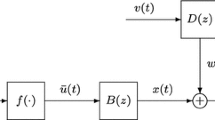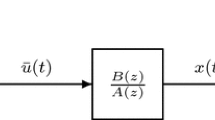Abstract
This paper considers the parameter estimation problems of Hammerstein–Wiener systems by using the data filtering technique. In order to improve the estimation accuracy, the data filtering-based recursive generalized extended least squares algorithm is derived. In order to improve the computational efficiency, the data filtering-based generalized extended stochastic gradient algorithm is derived for estimating the system parameters. Finally, the computational efficiency of the proposed algorithms is analyzed and compared. The simulation results indicate that the proposed algorithms can effectively estimate the parameters of Hammerstein–Wiener systems.





Similar content being viewed by others
References
Wang, X.H., Ding, F.: Convergence of the recursive identification algorithms for multivariate pseudo-linear regressive systems. Int. J. Adapt. Control Signal Process. (2016). doi:10.1002/acs.2642
Luan, X.L., Shi, P., Liu, F.: Stabilization of networked control systems with random delays. IEEE Trans. Ind. Electron. 58(9), 4323–4330 (2013)
Luan, X.L., Zhao, S.Y., Liu, F.: H-infinity control for discrete-time Markov jump systems with uncertain transition probabilities. IEEE Trans. Automat. Control 58(6), 1566–1572 (2013)
Shi, P., Luan, X.L., Liu, F.: H-infinity filtering for discrete-time systems with stochastic incomplete measurement and mixed delays. IEEE Trans. Ind. Electron. 59(6), 2732–2739 (2012)
Xu, L.: A proportional differential control method for a time-delay system using the Taylor expansion approximation. Appl. Math. Comput. 236, 391–399 (2014)
Xu, L., Chen, L., Xiong, W.L.: Parameter estimation and controller design for dynamic systems from the step responses based on the Newton iteration. Nonlinear Dyn. 79(3), 2155–2163 (2015)
Xu, L.: Application of the Newton iteration algorithm to the parameter estimation for dynamical systems. J. Comput. Appl. Math. 288, 33–43 (2015)
Xu, L.: The damping iterative parameter identification method for dynamical systems based on the sine signal measurement. Signal Process. 120, 660–667 (2016)
Chaudhary, N.I., Muhammad, M.A.Z.: Design of fractional adaptive strategy for input nonlinear Box–Jenkins systems. Signal Process. 116, 141–151 (2015)
Ding, F., Wang, X.H., et al.: Recursive least squares parameter estimation for a class of output nonlinear systems based on the model decomposition. Circuits Syst. Signal Process. (2016). doi:10.1007/s00034-015-0190-6
Chong, M.S., Nesic, D., et al.: Parameter and state estimation of nonlinear systems using a multi-observer under the supervisory framework. IEEE Trans. Automat. Control 60(9), 2336–2349 (2015)
Ding, F.: System Identification—Performances Analysis for Identification Methods. Science Press, Beijing (2014)
Chen, H.B., Xiao, Y.S., et al.: Hierarchical gradient parameter estimation algorithm for Hammerstein nonlinear systems using the key term separation principle. Appl. Math. Comput. 247, 1202–1210 (2014)
Vörös, J.: Iterative identification of nonlinear dynamic systems with output backlash using three-block cascade models. Nonlinear Dyn. 79(3), 2187–2195 (2015)
Halder, A., Bhattacharya, R.: Probabilistic model validation for uncertain nonlinear systems. Automatica 50(8), 2038–2050 (2014)
Janczak, A.: Instrumental variables approach to identification of a class of MIMO Wiener systems. Nonlinear Dyn. 48(3), 275–284 (2007)
Giri, F., Radouane, A., Brouri, A.: Combined frequency-prediction error identification approach for Wiener systems with backlash and backlash-inverse operators. Automatica 50(3), 768–783 (2014)
Hu, Y.B., Liu, B.L., et al.: A multi-innovation generalized extended stochastic gradient algorithm for output nonlinear autoregressive moving average systems. Appl. Math. Comput. 247, 218–224 (2014)
Ramezani, S.: Nonlinear vibration analysis of micro-plates based on strain gradient elasticity theory. Nonlinear Dyn. 73(3), 1399–1421 (2013)
Chen, H.B., Ding, F., Xiao, Y.S.: Decomposition-based least squares parameter estimation algorithm for input nonlinear systems using the key term separation technique. Nonlinear Dyn. 79(3), 2027–2035 (2015)
Wang, D.Q., Liu, H.B., et al.: Highly efficient identification methods for dual-rate Hammerstein systems. IEEE Trans. Control Syst. Tech. 23(5), 1952–1960 (2015)
Wang, C., Tang, T.: Several gradient-based iterative estimation algorithms for a class of nonlinear systems using the filtering technique. Nonlinear Dyn. 77(3), 769–780 (2014)
Hu, Y.B., Liu, B.L., et al.: Recursive extended least squares parameter estimation for Wiener nonlinear systems with moving average noises. Circuits Syst. Signal Process. 33(2), 655–664 (2014)
Shi, Y., Fang, H.: Kalman filter based identification for systems with randomly missing measurements in a network environment. Int. J. Control 83(3), 538–551 (2010)
Wang, D.Q., Ding, F., Chu, Y.Y.: Data filtering based recursive least squares algorithm for Hammerstein systems using the key-term separation principle. Inf. Sci. 222, 203–212 (2013)
Wang, D.Q., Zhang, W.: Improved least squares identification algorithm for multivariable Hammerstein systems. J. Frankl. Inst. Eng. Appl. Math. 352(11), 5292–5370 (2015)
Huang, J., Shi, Y., et al.: l-2-l-infinity filtering for multirate nonlinear sampled-data systems using T–S fuzzy models. Digit. Signal Process. 23(1), 418–426 (2013)
Ding, F., Wang, Y.J., Ding, J.: Recursive least squares parameter identification for systems with colored noise using the filtering technique and the auxiliary model. Digit. Signal Process. 37, 100–108 (2015)
Ljung, L.: System Identification: Theory for the User, 2nd edn. Prentice Hall, Englewood Cliffs (1999)
Ding, F.: System Identification—New Theory and Methods. Science Press, Beijing (2013)
Wang, Y.J., Ding, F.: Parameter estimation algorithms for Hammerstein-Wiener systems with autoregressive moving average noise. J. Comput. Nonlinear Dyn. (2016). doi:10.1115/1.4031420
Goodwin, G.C., Sin, K.S.: Adaptive Filtering, Prediction and Control. Prentice-Hall, Englewood Cliffs (1984)
Golub, G.H., Van Loan, C.F.: Matrix Computations, 3rd edn. Johns Hopkins University Press, Baltimore (1996)
Ji, Y., Liu, X.M., et al.: New criteria for the robust impulsive synchronization of uncertain chaotic delayed nonlinear systems. Nonlinear Dyn. 79(1), 1–9 (2015)
Ji, Y., Liu, X.M.: Unified synchronization criteria for hybrid switching-impulsive dynamical networks. Circuits Syst. Signal Process. 34(5), 1499–1517 (2015)
Zhu, D.Q., Huang, H., Yang, S.X.: Dynamic task assignment and path planning of multi-AUV system based on an improved self-organizing map and velocity synthesis method in 3D underwater workspace. IEEE Trans. Cybern. 43(2), 504–514 (2013)
Sun, B., Zhu, D.Q., Yang, S.X.: A bio-inspired filtered backstepping cascaded tracking control of 7000m manned submarine vehicle. IEEE Trans. Ind. Electron. 61(7), 3682–3692 (2014)
Acknowledgments
This work was supported by the National Natural Science Foundation of China (No. 61273194) and the PAPD of Jiangsu Higher Education Institutions.
Author information
Authors and Affiliations
Corresponding author
Rights and permissions
About this article
Cite this article
Wang, Y., Ding, F. Recursive least squares algorithm and gradient algorithm for Hammerstein–Wiener systems using the data filtering. Nonlinear Dyn 84, 1045–1053 (2016). https://doi.org/10.1007/s11071-015-2548-5
Received:
Accepted:
Published:
Issue Date:
DOI: https://doi.org/10.1007/s11071-015-2548-5




